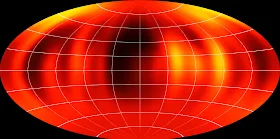Καλλιτεχνική
απεικόνιση του καφέ νάνου στον οποίο βρέχει λιωμένο σίδηρο. This
artist's impression is based on the first ever map of the weather on the
surface of the nearest brown dwarf to Earth. An international team has used
ESO's Very Large Telescope to make a chart of the dark and light features on
WISE J104915.57-531906.1B, which is informally known as Luhman 16B and is one
of two recently discovered brown dwarfs forming a pair only six light-years
from the Sun. Note that the faint fine detail on the surface has been added for
artistic effect. Image released Jan. 29, 2014. Credit: ESO/I. Crossfield/N.
Risinger (skysurvey.org)
Ομάδα
ερευνητών κατάφερε να «δει» τις καιρικές συνθήκες που επικρατούν σε κοντινό στη
Γη καφέ νάνο. Η πιο ενδιαφέρουσα και εντυπωσιακή ανακάλυψη είναι ότι στον καφέ
νάνο υπάρχουν έντονες βροχοπτώσεις - μόνο που αντί για νερό τα νέφη τον
βομβαρδίζουν με… λιωμένο σίδηρο.
«Αποτυχημένοι»
αλλά θυελλώδεις
ESO's Very Large
Telescope has been used to create the first ever map of the weather on the
surface of the nearest brown dwarf to Earth. An international team has made a
chart of the dark and light features on WISE J104915.57-531906.1B, which is
informally known as Luhman 16B and is one of two recently discovered brown
dwarfs forming a pair only six light-years from the Sun. Credit: ESO/I. Crossfield
Καφέ
νάνοι ονομάστηκαν τα σώματα που βρίσκονται σε μια ενδιάμεση κατάσταση ανάμεσα
σε πλανήτες και άστρα με τους περισσότερους ειδικούς να κάνουν λόγο για…
«αποτυχημένα άστρα». Πριν από λίγες
εβδομάδες επιστήμονες στις ΗΠΑ παρατήρησαν 44 καφέ νάνους και, όπως
διαπίστωσαν, σε αυτούς εξελίσσονται ακραίες καιρικές συνθήκες. Οι ερευνητές με
επικεφαλής επιστήμονες του Πανεπιστημίου της Καλιφόρνια «είδαν» τρομερές
θύελλες σε περίπου 20 καφέ νάνους. Όπως ανέφεραν, σε πολλούς καφέ νάνους
μαίνονται πολύ μεγάλης έντασης τυφώνες που συνοδεύονται από εκτυφλωτικές
αστραπές ενώ επίσης βρέχει λιωμένο σίδερο και «χιονίζει» καυτή άμμο.
«Γειτονική»
επιβεβαίωση
ESO's Very Large
Telescope has been used to create the first ever map of the weather on the
surface of the nearest brown dwarf to Earth. An international team has made a
chart of the dark and light features on WISE J104915.57-531906.1B, which is
informally known as Luhman 16B and is one of two recently discovered brown
dwarfs forming a pair only six light-years from the Sun. The figure shows the
object at six equally spaced times as it rotates once on its axis. Image
released Jan. 29, 2014.
Credit: ESO/I. Crossfield
Ο
Luhman 16B βρίσκεται σε απόσταση 6.7 έτη φωτός από τη Γη και είναι ο τρίτος
κοντινότερος σε εμάς καφέ νάνος. Ερευνητές με επικεφαλής επιστήμονες του
Ινστιτούτου Μαξ Πλανκ χρησιμοποίησαν το τηλεσκόπιο VLT του Νότιου Ευρωπαϊκού
Αστεροσκοπείου στη Χιλή και εστίασαν την προσοχή τους στον Luhman 16B. Η πρώτη διαπίστωση των ερευνητών ήταν πως ο
Luhman 16B καλύπτεται από ανομοιόμορφες νεφώσεις στις οποίες επικρατούν πολύ
υψηλές θερμοκρασίες. Σύμφωνα με τους υπολογισμούς των ερευνητών η θερμοκρασία
στα νέφη του Luhman 16B αγγίζει τους 930 βαθμούς Κελσίου. Οι ερευνητές
διαπίστωσαν επίσης ότι στον Luhman 16B βρέχει λιωμένο σίδηρο επιβεβαιώνοντας
την προηγούμενη μελέτη.
This video starts
with a broad view of the entire sky and closes in on the southern constellation
of Vela (The Sails). Among huge numbers of faint stars, a very faint double
object appears. This is WISE J104915.57-531906.1AB, which is informally known
as Luhman 16AB. It is a recently discovered pair of brown dwarfs only six
light-years from the Sun. The video then takes you on a fly-through of the
space around the nearest stars to the Sun. Some familiar stars are visible,
such as Alpha Centauri, Sirius and Barnard's Star, but there is also a faint
object only discovered in early 2013 — this is WISE J104915.57-531906.1AB,
which is informally known as Luhman 16AB. It is the third closest system to the
Solar System. An artist's impression based on the first ever map of the weather
on the surface of the nearest brown dwarf to Earth. An international team used
ESO's Very Large Telescope to make a chart of the dark and light features on
WISE J104915.57-531906.1B, which is informally known as Luhman 16B. Luhman 16A
appears in the background in this sequence. Note that the faint fine detail on
the surface of Luhman 16B has been added for artistic effect. The first ever
map of the weather on the surface of the nearest brown dwarf to Earth shows the
object as it rotates on its axis.
Η
νέα μελέτη δημοσιεύεται στις επιθεωρήσεις «Nature» και «Astrophysical Journal Letters»
και αποτελεί ένα ακόμα βήμα προόδου για τη νέα επιστήμη της
«αστρο-μετεωρολογίας». Οι επιστήμονες που δραστηριοποιούνται σε αυτόν τον τομέα
ευελπιστούν ότι σύντομα θα αναπτύξουν τις μεθόδους και τα εργαλεία για να
κάνουν προβλέψεις για τον καιρό σε εξωπλανήτες. Η ανάπτυξη της
αστρο-μετεωρολογίας θεωρείται πολύ σημαντική στην προσπάθεια εντοπισμού ενός
πλανήτη φιλόξενου για την παρουσία της ζωής.



Δεν υπάρχουν σχόλια:
Δημοσίευση σχολίου